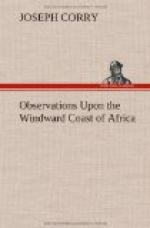Indian corn, or maize, may be reaped several times throughout the year, only requiring about three months growth.
Millet, with a multiplicity too tedious to enumerate.
Sugar canes are not very abundant, but are of a good quality, which, under careful management and industry, would, no doubt, yield productive returns.
Coffee trees, of different nondescript species, only requiring the same interference.
Dyes, of infinite variety and superior texture: yellow is procured from the butter and tallow tree, producing a juice resembling gamboge, but more cohesive, and of a darker colour; the wood of this tree is firm, and adapted to a variety of purposes; its fruit is about the size of a tennis ball, nearly oval, thick in the rind, and of a pleasant acid taste, containing several seeds about the size of a walnut, and yielding a viscous substance used by the natives in their food. Red and black are procured from a variety of other trees and plants; and indigo growing in wild exuberance, particularly in the rivers more to the northward.
Cotton, in great varieties, requiring only cultivation to raise it to perfection and amount. The natives manufacture from it a narrow cloth, which is made from thread, spun in a manner similar to the distaff.
A species of silk cotton, or ether down, is produced on a large tree, called the pullam tree. The quantity which the usual size bears may be computed at about 4 cwt. in pods of 6 to 9 inches long, 4-1/2 in circumference, and about 1-1/2 inch in diameter, which, upon being exposed to the heat of the sun, is distended to an incredible bulk. It is much superior to down for the couch, and, from its elasticity, might be of great utility in the manufacture of hats. This tree is in great estimation among the Africans, and is frequently regarded by them as their Fetish. Every town almost has a tree of this species towering over its huts, which its chief tells the traveller with exultation he or his father planted.
Tobacco is uncertain, but I entertain very little doubt that it might be raised upon the more luxuriant soils.
Pepper, more particularly near Cape Mount, of several sorts, Maboobo, Massaaba, Massa, Amquona, Tosan, &c.; the three first are of a weaker flavour, and are oblong and angular in their seeds; but the last excels in pungency, and is the native Malaguetta pepper of Africa.
The bread-fruit tree, is similar in appearance to the apple tree, and grows in the low sandy situations of the Boolum shore, producing a fruit exceedingly nutritious, and larger than an apple.
Tamarinds in great variety and plenty: the velvet tamarind abounds in the Bananas, also the white and brown; but the latter are most in esteem, and are very fine.
Okras, the fruit of a small tree, resembling the English mallows, which put into soup gives it a gelatine quality, highly alimental; the leaves make a good spinage.




